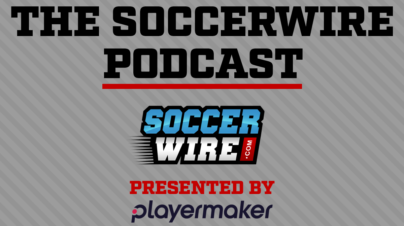Lesson for a Young Soccer Coach

By Dan Blank
Soccer Coach & Best Selling Author
Frustrated with the officiating of a match, a coaching friend of mine once said he was convinced that center officials are subconsciously hoping for a draw. It’s not as farfetched as you might think. It might be harder to understand if you’ve never coached, but I have, and I gotta say, I did the same darn thing. I did it for years actually.
If I’m watching a game of anything as neutral party – a game I have no vested interest in – I’m naturally sympathetic to the team with the greater immediate struggle – the team that is trailing. I couldn’t care less about who wins a game between the 49ers and the Broncos, but on the off chance that I tuned into that game and saw that Denver was down by ten points in the third quarter, I’ll find myself quietly rooting for the Broncos. And then, if the Broncos take the lead midway through the fourth, my allegiance will immediately shift and suddenly I’ll be pulling for the 49ers. Sounds strange, but I can’t be alone on this. It’s not even that I’m rooting for an exciting game. I think it’s more like I just don’t want to see either team lose (a problem I don’t have if one of the teams is the Cowboys, Giants or Patriots).
Here’s an actual example from this past August. It’s the Little League World Series – the US championship game, with the winner playing for the world title. Scoreless through four innings, Louisiana comes to life with four runs in the top of the fifth, and then puts the game out of reach plating five more an inning later. I feel bad for the kids from Hawaii who are down 9-0, so naturally I start rooting for them.
In the bottom of the sixth (and final) inning, Hawaii rallies. The first three batters reach base. A couple of walks and an error and it’s raining runs for the boys from Maui. The wheels are coming off for Louisiana and suddenly it’s 9-5 with the bases still loaded and only one out, and now I’m feeling bad for Louisiana because I can’t imagine how awful it would feel for the pitchers who might have to live with the idea of blowing a nine-run lead in the bottom of the last inning. By the way, this was one of the best baseball games you’ll ever see. Anyway, the next batter hits a line drive to the shortstop who snatches it and doubles the runner off second base and the game is over. Helluva game to be sure, but why did I do such a flip-flop? Because I hate seeing someone lose. Unless it’s to me. Which is fine. But I know the pain of losing, of failing in the big moment, and I hate for anyone to go through it. So I guess if you peel away enough layers, I was rooting for a tie – a game that would go on forever, unsettled. There are certainly worse things in this world.
In my early years of coaching, I had the same problem with my own team when we would divide up and play small-sided games. It wasn’t that I wasn’t emotionally invested; it was that I was equally invested with both teams. It took me close to a decade to figure it out, but because I’m smart and stuff, eventually I realized how my desire for my players to avoid defeat during training sessions was probably leading them to experience actual defeat on game days.
Are you a coach who, during intra-squad games, finds himself coaching harder for the group that is trailing? Are you trying to show them the path back to level? Are you trying to help the group that needs immediate help? Give it an honest think. Now, think about the message you’re sending to both sets of players.
I addressed the issue in my book In My Tribe, and I think it’s one of the most important lessons I learned along the way:
On my journey to alter the pathology of my players, I discovered that we were all tripping over one of my own habits. When I was a young coach and had my team playing small-sided games, I always took up for the side that was losing. I would urge them to work harder. I would give them more instruction. I did everything I could do from the sideline to get them back in the game. I guess it was just my nature to pull for the underdog. I didn’t recognize it at the time, but subconsciously I was rooting for a tie.
Eventually I realized that I was an idiot. My approach was counterproductive to the goal of creating uber-competitors. How can you expect your players to develop a cutting edge when their coach roots against them every time they take a lead? Surely there’s a psychologist out there who will say that my approach was attaching an undertone of guilt to the prospect of breaking an opponent’s spirit, or that I was rewarding the losing side with my attention. Either way, it’s a bad message to send to a group of players who are ultimately measured on wins and losses.
Eventually I woke up and did an about-face. When we played small-sided games, I didn’t actively pull for one team or the other until one of those teams went up by two or three goals. If I thought the trailing team was dogging it, I’d start shouting encouragement to the team with the lead, urging them to punish the opponent. When you’re a player and your team is losing and everything is falling apart, the last thing you want to hear is your coach cheering for the team that’s kicking your ass, but I didn’t care. I wanted to send the message that I’m going to side with the winners. If you don’t like it, do something to change the game. In the meantime, I wanted the team that was winning to go in for the kill. I wanted them to know that turning the knife was the right thing to do. I sincerely believe that this change in approach had a significant impact on the mentality of my teams.
Competitors can sniff out an opponent’s vulnerable spirit during a match. You might see something in her body language, or catch something she mumbles under her breath or says to a teammate, but to a competitor, that moment of weakness is unmistakable. You sense that the opponent’s foundation is ready to collapse. That’s your chance to end the fight. That’s when the assassin must take over and put the opponent out of her misery. I was seeing more and more of that in our training sessions. Taking a lead no longer meant slowing down; it meant stepping on the gas. Our habit of easing up was replaced by a burning urgency to break spirits and end the fight.
If you can clear the emotional hurdle of breaking your friend’s spirit, then breaking a stranger’s spirit isn’t only easy – it’s fun! So as you might imagine, this bloodlust carried over seamlessly into our matches. I had a group of players that would pounce when they sensed weakness. We could turn a game that had been a competitive stalemate into a rout better than any team I’ve ever coached. If an opponent made a mistake anywhere close to its own goal, you could hear a chorus of voices shouting, “Punish it!” They understood the need to strike when the iron was hot and break spirits that were begging to be broken. We were breeding a sense of urgency in training sessions that was resurfacing when it mattered most – against the actual opponents. Suddenly, those winnable games were actually ending up in the win column.
My point is this: If you’re a young coach (or even a not-so-young coach) and you want your players to develop a razor-sharp edge, you can’t hedge your bets at training. You’ve got to reward the team that is actually doing its job by chopping its opponents into little pieces – even if the losing team is also collection of your own players who you love dearly.
Players will internalize your message, regardless of what that message is. If the message you’re sending is internalized as a reward to the team that is trailing, then you can be sure that your team will do a lot of exactly that – trailing.
You have to reinforce the messages that are important to you. For me that meant reinforcing the message that you don’t let a wounded opponent recover – that when you have them in trouble, you go in for the kill.
Eventually I stopped rooting for a tie. Amazing what a difference that made.
If you enjoyed this post, check out In My Tribe or one of my other books on Amazon.
SOCCERWIRE MARKETPLACE
- The St. James FC Virginia 2024-2025 Travel Tryouts
- TSJFCV - Hiring Travel Soccer Coaches
- Hiring: U13-U19 Boys Director
- Coaches Needed
- Train with professional AC Milan coach
- Loudoun Soccer 2024/25 Travel Player Placement Sessions
- Official Elite Summer Soccer Camps with Elite Pro Clubs in Europe
- Official EPL Tickets: ARSENAL, LIVERPOOL, TOTTENHAM & MORE
- Travel to Denmark for Dana Cup Hjørring 2024
- New England Surf Challenge and Showcase 2024















